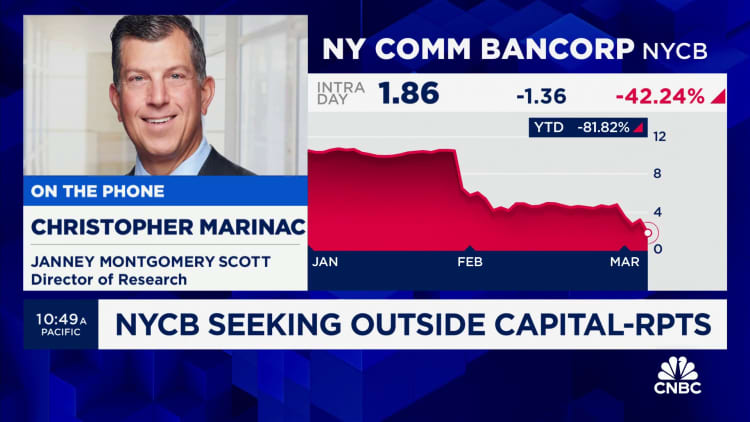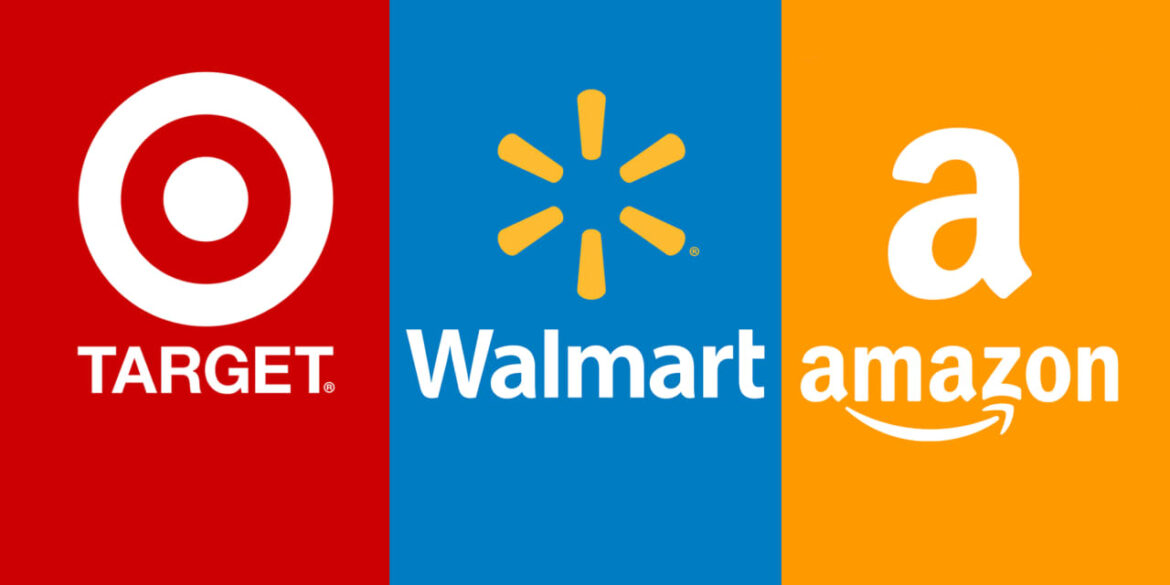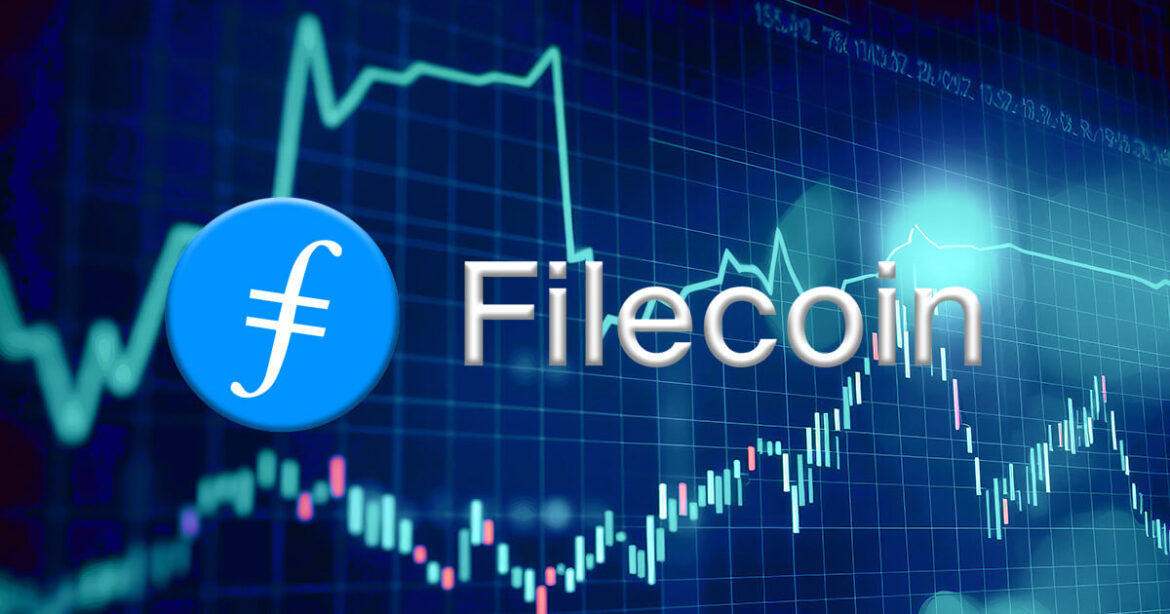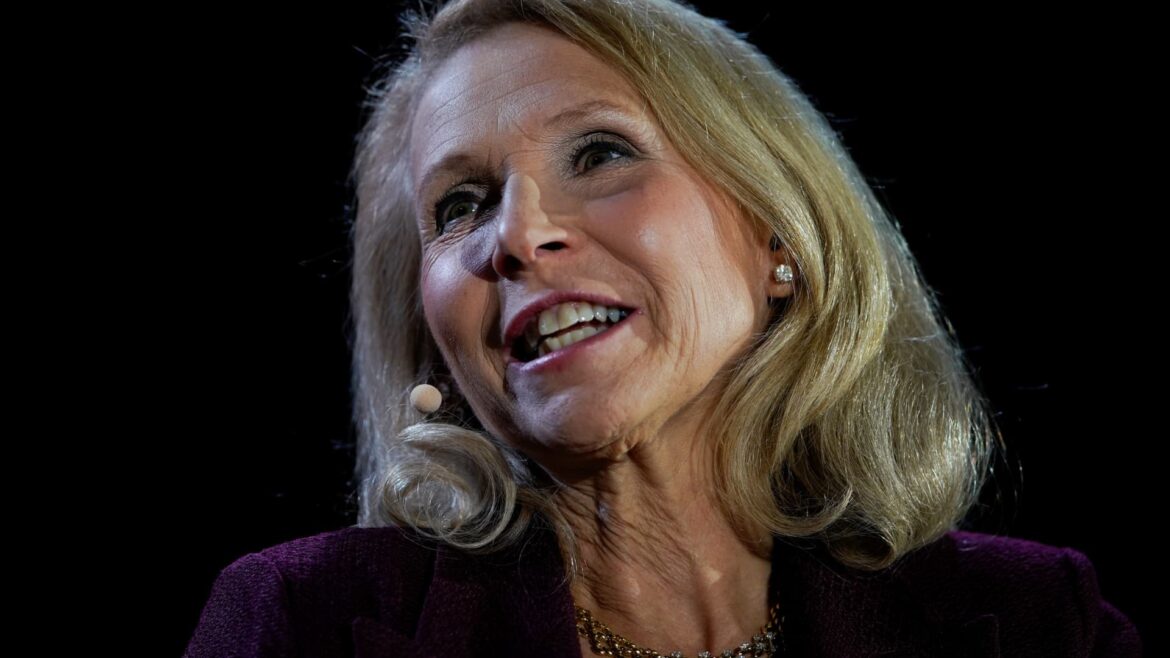
“When one friend made a fuss over wanting to fly business class, I threatened to cancel completely.”
Source link
Deal
Federal Reserve Chair Jerome Powell fist-bumps former Treasury Secretary Steven Mnuchin after a House Financial Services Committee hearing on “Oversight of the Treasury Department’s and Federal Reserve’s Pandemic Response” in the Rayburn House Office Building in Washington, D.C., on Dec. 2, 2020.
Greg Nash | Reuters
The $1 billion-plus injection that New York Community Bank announced Wednesday is the latest example of private equity players coming to the need of a wounded American lender.
Led by $450 million from ex-Treasury Secretary Steven Mnuchin’s Liberty Strategic Capital, a group of private investors are plowing fresh funds into NYCB. The move soothed concerns about the bank’s finances, as its shares closed higher on Wednesday after a steep decline earlier in the day.
That cash infusion follows last year’s acquisition of PacWest by Banc of California, which was anchored by $400 million from Warburg Pincus and Centerbridge Partners. A January merger between FirstSun Capital and HomeStreet also tapped $175 million from Wellington Management.
Speed and discretion are key to these deals, according to advisors to several recent transactions and external experts. While selling stock into public markets could theoretically be a cheaper source of capital, it’s simply not available to most banks right now.

“Public markets are too slow for this kind of capital raise,” said Steven Kelly of the Yale Program on Financial Stability. “They’re great if you are doing an IPO and you aren’t in a sensitive environment.”
Furthermore, if a bank is known to be actively raising capital before being able to close the deal, its stock could face intense pressure and speculation about its balance sheet. That happened to Silicon Valley Bank, whose failure to raise funding last year was effectively its death knell.
On Wednesday, headlines around noon that NYCB was seeking capital sent its shares down 42% before trading was halted. The stock surged afterward on the news that it had successfully raised funding.
“This is the unfortunate lesson from SVB,” said an advisor on the NYCB transaction. “With private deals, you can talk for a while, and we almost got to the finish line before there was any publicity.”
Mnuchin’s outreach
Mnuchin reached out to NYCB directly to offer support amid headlines about the duress it was under, according to a person with knowledge of the matter. Mnuchin isn’t just a former Treasury secretary. In 2009, he led a group that bought California bank IndyMac out of receivership. He ultimately turned the bank around and sold it to CIT Group in 2015.
Now, with the assumption that Mnuchin and his co-investors have seen NYCB’s deposit levels and capital situation — and are comfortable with them — the bank has much more time to resolve its issues. Last week, NYCB disclosed “material weaknesses” in the way it reviewed its commercial loans and delayed the filing of a key annual report.
“This buys them a ton of time. It means the FDIC isn’t coming to seize them on Friday,” Kelly said. “You have a billion dollars in capital and a huge endorsement from someone who has seen the books.”
Don’t miss these stories from CNBC PRO:
Digihost Secures Hosting Deal for 4,640 S19 XPs With Leading Bitcoin Miner Manufacturer
 Digihost Technology Inc., a blockchain technology and mining enterprise based in the U.S., revealed a significant augmentation of its bitcoin mining capabilities, courtesy of a multi-year hosting contract with a “leading” global provider of digital currency mining equipment. Digihost Expands Mining Fleet Under Newly Inked Multi-Year Hosting Deal Digihost (Nasdaq: DGHI; TSXV: DGHI) said the […]
Digihost Technology Inc., a blockchain technology and mining enterprise based in the U.S., revealed a significant augmentation of its bitcoin mining capabilities, courtesy of a multi-year hosting contract with a “leading” global provider of digital currency mining equipment. Digihost Expands Mining Fleet Under Newly Inked Multi-Year Hosting Deal Digihost (Nasdaq: DGHI; TSXV: DGHI) said the […]
Source link
Target Circle 360, Amazon Prime or Walmart+: Which membership is the best deal?

One more big retailer wants you to consider same-day delivery — for an added cost.
Target Corp.
TGT,
will be joining Walmart Inc.
WMT,
Amazon.com Inc.
AMZN,
and other retailers in the same-day delivery game by introducing a new tier to its membership program called Target Circle 360. Available starting April 7, Target Circle 360 will cost $49 a year. Members will be able to have food, clothes and most other Target products delivered to their doorstep on the same day they order them.
Target’s Circle 360 program is part of the retailer’s effort to relaunch its Target Circle membership program, a free program that gives shoppers access to rewards and discounts. Target Circle members can opt for further deals, either by applying for a Target Circle Card — which can be either a credit, debit or reloadable card — or by paying to become a Target Circle 360 member. Target announced the plan to its investors Tuesday during its quarterly earnings call.
Members who sign up for a Target Circle Card — previously known as Target RedCard — get an extra 5% off each order. Cardholders and Circle 360 members also get access to free two-day delivery on eligible items.
Compared to Walmart and Amazon, Target offers a much more curated and smaller selection of products, but Target Circle 360 members can also enjoy same-day delivery service for items from other retailers through Shipt Marketplace, an online multi-retailer delivery platform. Target bought Shipt in 2017 and started experimenting with same-day delivery on occasions such as last Christmas.
After the promotional period ends on May 18, the new Target Circle 360 same-day delivery membership will cost $99 a year for shoppers who aren’t Target cardholders. For Target’s cardholders, the price for Target Circle 360 will stay at $49 per year. The membership is comparable to Shipt’s membership program, which costs $99 a year for same-day delivery.
Same-day delivery became popular during the pandemic for purchasing groceries, though consumer interest didn’t wane once in-person shopping became available again.
“Shopping is dynamic, and so are we. The investments we’re making reflect our focus on consumers’ preferences and needs,” said Cara Sylvester, Target’s executive vice president and chief guest experience officer, on the company’s earnings call Tuesday.
Walmart introduced its Walmart+ program in 2020. On the company’s latest earnings call, executives said delivery has become a key driver to attract high-income shoppers and Walmart+ members. Members spend nearly twice as much at Walmart compared to non-members, Walmart Chief Executive Doug McMillon told investors.
From Target to Walmart to Amazon, how do these memberships compare to each other and which one offers the best deal?
How much do Target Circle 360, Amazon Prime and Walmart+ cost? Are there discounts?
Walmart+ costs $98 a year, or $12.95 a month. Amazon Prime costs $139 a year, or $14.99 a month. Amazon Prime offers discounts for students from 18 to 24 years old, as well as those receiving government assistance. The online retailer offers Prime membership at $7.49 a month for eligible students and $6.99 a month for those receiving government assistance such as Medicaid and nutrition programs.
Amazon Prime has become more expensive in recent years. It cost $99 a year before 2018, then $119. Then in 2022, Amazon upped the price to $139 a year.
An Amazon spokesperson defended the price increases. “Prime has always delivered disproportionate value to its members and will always do so,” Kristin Lunghamer, an Amazon spokesperson, told MarketWatch in an email. The company “improves the membership each year with more selection, value and convenience,” she added.
Over the past few years, Amazon has acquired other businesses and made access to their services a feature of Prime memberships. This includes access to One Medical, an on-demand medical service.
What’s the minimum cost of same-day delivery for Target Circle 360, Walmart+ and Amazon Prime?
Target’s same-day delivery service will be available for Target Circle 360 members on orders of $35 and up, which is the same threshold as Walmart+’s same-day delivery service. While Target says its same-day deliveries can arrive in “as little as an hour,” Walmart asks members to choose its Express Delivery option for an item to arrive within an hour, which costs an additional $10.
Target Circle 360 members who don’t meet the $35 minimum will have to pay an additional $7 to get standard same-day delivery, a Target representative told MarketWatch in an email. For orders below $35, Walmart+ charges a $6.99 fee.
While Amazon Prime offers various free-delivery options, including one-day delivery and same-day delivery, each delivery from Amazon’s Fresh grocery-delivery service must be at least $100 to qualify for free shipping, which Amazon says will arrive within two hours. Amazon lowered this minimum dollar amount in October, from $150.
What other perks do you get with Target Circle 360, Amazon Prime and Walmart+ aside from same-day delivery?
While Target’s new offering is mainly focused on shopping and delivery, Amazon Prime and Walmart+ both offer other services with their subscriptions, such as streaming services.
Walmart+ members get free access to Paramount+ Essential, which usually costs $5.99 a month, or $59.99 a year. Amazon Prime users get access to Amazon’s digital products, including Prime Video, but there’s a catch: Users have to pay an extra $2.99 a month if they don’t want to see ads during their Prime Video shows and movies.
Aside from streaming and digital services, Walmart+ also offers additional savings such as lower prices on auto care and discounts on booking travel. Amazon Prime also comes with a free Grubhub+ membership for one year.
Fisker seeks deal with another carmaker to remain afloat, shares plunge

Fisker Inc. shares fell 37% in extended trading Thursday after the EV maker said it was brokering a deal with an unnamed “large” carmaker as it seeks to remain in business, adding that there would be “substantial doubt” about its ability to do just so without a capital injection.
The deal could include an investment in Fisker
FSR,
a joint development of one or more electric-vehicle platforms and North American manufacturing, Fisker said.
Fisker has been dubbed the “Apple of autos,” having inked deals with manufacturers to produce its EVs and choosing to focus on the design side of the business.
The company also said that its current resources are insufficient to meet its needs over the next 12 months, and that it will need to seek additional equity or debt financing.
If there’s no financing or if financing terms are “less desirable” than expected, the company “may be forced to decrease its planned level of investment in product development, scale back its operations including further headcount reductions, and reduce production of the Fisker Ocean, which could have an adverse impact on the company’s business and financial prospects,” the EV maker said.
“As a result, the company expects to conclude there is substantial doubt about its ability to continue as a going concern when its annual financial statements for the year ended December 31, 2023, are filed with the SEC,” it warned.
Fisker said it would cut about 15% of its workforce, and that the reductions are mostly related to the change in its sales strategy from a direct-to-consumer model to a dealer-partner model. It was not immediately clear how many employees Fisker currently has, and the company did not return a request for information.
The company became a public through a merger with a blank-check company in July 2020.
It had an earlier life as privately held Fisker Automotive, which went bankrupt in 2013 after six years in business. The company’s assets were acquired by a Chinese auto-parts maker that also owned the company supplying batteries to Fisker, A123 Systems.
A123 Systems went bankrupt as well, hastening the demise of the old Fisker. The founder of Fisker Automotive, Danish designer Henrik Fisker, had resigned from the company’s amid board infighting just before the bankruptcy, but he retained some brand rights and went on to found Fisker Inc.
Last year was “challenging” for Fisker, including delays with suppliers and other issues that prevented the EV maker from delivering its Ocean SUVs “as quickly as we had expected,” Henrik Fisker said in the company’s statement.
“We also encountered unexpected headwinds in our efforts to establish a direct-to-consumer sales model in both North America and Europe at the same time,” plus “unanticipated challenges” such as rising interest rates and a tight labor market, he said.
Besides the layoffs, Fisker is also streamlining operations, including reducing its physical footprint and overall expenses.
Fisker reported fourth-quarter sales of $200 million, well bellow FactSet consensus for sales of $327.7 million for the quarter.
The EV maker lost $463.6 million, or $1.23 a share, in the quarter, compared with a loss of 34 cents a share in the fourth quarter of 2023. The analysts surveyed by FactSet expected a GAAP loss of 23 cents a share.
Fisker shares have lost 90% in the past 12 months, contrasting with gains of around 28% for the S&P 500 index
SPX.
U.S. Senate Majority Leader Chuck Schumer, D-N.Y., and U.S. Speaker of the House Mike Johnson, R-L.a., speak to each other during a Capitol Menorah lighting ceremony at the U.S. Capitol Building in Washington, D.C., on Dec. 12, 2023.
Anna Moneymaker | Getty Images
Top congressional leaders on Capitol Hill struck a partial budget deal to temporarily avert a government shutdown on Wednesday.
Leaders including House Speaker Mike Johnson, R-La., and Senate Majority Leader Chuck Schumer, D-N.Y., secured an agreement for six funding bills, four of which were to expire Friday.
Those bills and their corresponding agencies, which included agriculture, veterans affairs and housing, will now remain funded through March 8. The rest of the government’s funding will be extended to March 22.
“We are in agreement that Congress must work in a bipartisan manner to fund our government,” leaders said in a joint statement.
The House is expected to vote on the deal as early as Thursday, with the Senate to follow and Biden to sign after that.
The funding extensions are intended to give Congress “adequate time” to draft language for the agreed-upon bills, give congress members time to review the text and conduct other technical legislative processes, the joint statement said.
Johnson had only agreed to extend those funding deadlines if an agreement on the six bills could be reached, according to a person familiar with the negotiations. Otherwise, the government could have headed into partial shutdown on Saturday.
Government shutdowns do not tend to move markets significantly, though they can stoke perceptions of economic uncertainty.
Congressional leaders had been optimistic about getting the deal settled, especially after a Tuesday White House meeting with President Joe Biden and Congress’ top four leaders, including Johnson.
This is the fourth time this fiscal year that Congress has had to pass a short-term spending bill to keep the government funded and avert a near-miss shutdown.
Don’t miss these stories from CNBC PRO:
Filecoin surges to new highs fueled by pivotal Solana deal and AI sector growth

Filecoin has surged to a new yearly high amid significant development within its ecosystem.
The decentralized storage protocol’s FIL token price soared to a yearly peak of $8.43 but has slightly corrected to $7.92 as of press time, according to CryptoSlate data.
Notably, FIL is the only digital asset among the top 25 cryptocurrencies by market capitalization that saw a green candle in the last 24 hours, up more than 7% during the reporting period.
Over the past 30 days, FIL has grown by more than 63.61% and by 15% on the year-to-date metric. Despite this growth, Filecoin remains down about 96.54% from its all-time high of $236.965 in April 2021.
Why is Filecoin’s value rising?
FIL’s price performance can be attributed to several reasons, including recent developments within its ecosystem and the current artificial intelligence (AI) narrative pervading the broader market.
During the past week, Filecoin announced a significant partnership with the leading blockchain network, Solana.
According to the announcement, the collaboration would allow infrastructure providers, explorers, indexers, and anyone needing historical access to have seamless access to Solana’s block history.
“By leveraging Filecoin’s decentralized storage capabilities, Solana can achieve data redundancy, scalability, and enhanced security while staying true to its decentralized ethos,” it added.
Besides that, market observers have highlighted the current AI narrative as another reason for FIL’s bullish price performance.
Recent reports revealed that AI-linked tokens have rapidly gained after OpenAI announced its AI-powered video generation service, Sora. In addition, Nvidia’s recent earning report showed a massive demand for generative AI.
Considering this, Arthur Hayes, the co-founder of the BitMEX exchange, said, “All things AI-related [will] levitate.” According to him, this would push FIL’s price to $100.
Furthermore, a recent report from the protocol highlighted increased accessibility and demand for its products in the previous year. Notably, the protocol onboarded over 1,800 new large dataset clients and more than 180 clients to Singularity alone.
Opinion: How restaurant-week offers can end up being being a bad deal

When it comes to dining out, I love a good deal as much as anyone else. Which means I’ve always anticipated Restaurant Week, that promotion in my hometown of New York City where hundreds of establishments offer multi-course meals at a discount.
But in recent years, I’ve noticed the math hasn’t always added up to my advantage. In one case, I visited a restaurant and realized my three-course dinner would cost less if I ordered the items a la carte. “So, why don’t you do that?” the server suggested when I pointed out the absurdity of the situation.
Sure enough, I didn’t opt for the “deal” and instead picked my way through the menu like a regular-paying customer. But the episode stuck with me as a telling example of how what once seemed like a smart idea — a way for customers to explore dining spots without having to dig as deep into their pockets while also giving restaurants an opportunity to gain new business — has perhaps played itself out.
Of course, if you look at how New York’s Restaurant Week has grown you might think otherwise. What began as a one-time promotion in 1992 with a mere 94 participating establishments has become an ongoing marketing extravaganza. There are now two separate such weeks in the city — one in the winter (it just concluded, in fact), another in the summer. And the timeframe for each promotion is not a “week” but more like half a month. Participation has also soared to 600-plus establishments, which offer prix-fixe meals from $30 to $60.
“When a skeptical colleague heard me talking about this, he joked, ‘What about Tuscaloosa?’ Sure enough, the Alabama city launched its promotion last year.”
Perhaps the most significant development is that the New York event has spawned dozens, if not hundreds, of copycats across the country — not only in big cities such as Chicago and Los Angeles, but also, well, just about everywhere. When a skeptical colleague heard me talking about this, he joked, “What about Tuscaloosa?” Sure enough, the Alabama city launched its promotion last year.
Granted, each place puts its own spin on the event. In Chicago, they’ve added a big one-night food festival, dubbed the First Bites Bash, as a kickoff to the event. In Los Angeles, they’ve featured dining deals for as little as $15. And in Tuscaloosa, they’re simply looking to take pride in a homegrown restaurant scene that promotion organizers say goes far beyond barbecue and other Southern staples.
The message was heard loud and clear during the Tuscaloosa event’s first edition, says Kelsey Rush, president of Visit Tuscaloosa, the tourism board that’s behind the newly established Restaurant Week. Rush said one place was so busy with a fish special they ran during the promotion, they had to reach out to their supplier twice during the week to get more of the catch.
“We had great success stories,” Rush said of the overall response to the citywide event.
Maybe that’s true. And yet, I still cast a somewhat skeptical eye, if not on Tuscaloosa’s event itself then on the broader state of restaurant weeks.
The value equation
Begin with the value equation: As any restaurant-industry consultant or expert will tell you, eateries always operate on tight margins, which makes it hard for them to offer deals in the best of times. Now, with rising food and labor costs, it’s harder than ever.
That means the only way a lot of these restaurant-week bargains can work is for the operator to trim costs — say, by offering smaller portion sizes or using cheaper cuts of meat. But in the end, that doesn’t exactly make for a satisfying meal, says Allen Salkin, a veteran food journalist who has done his fair share of restaurant-week dining across the country.
“You want to pay less for better, not less for less,” he told me.
Or they can go another route and try to entice diners to pay for extras — certainly, a cocktail or a glass of wine, but also for add-on foods. I even spotted New York restaurants that had a surcharge for bread. One example: Gotham, an acclaimed Manhattan dining destination, levies a $6 fee for its “housemade bread” with “cultured butter.”
Gotham managing partner Bret Csencsitz told MarketWatch that the bread charge has been in place on an ongoing basis — and not just for Restaurant Week. It is “based on the fact that the cost of doing business has dramatically increased on all fronts from labor to ingredients, to delivery surcharges, etc.,” he said via email.
“‘You want to pay less for better, not less for less.’”
— Food journalist Allen Salkin
My frustrations go beyond the bargain aspect (or lack thereof). What used to make restaurant-week promotions special was that they were limited in how long they ran, limited in how many restaurants participated in it and, yes, limited in how many places offered them.
I suppose it’s unfair to begrudge other metro areas from joining the club, especially if it helps bring in customers to their restaurants (the promotions are often timed during slower dining seasons, such as the post-holiday January period). But I also wonder if those places could come up with something unique rather than jumping on the bandwagon.
It’s not just me who sees the issue. “It’s the same-old, same-old,” said Florida-based marketing consultant Craig Agranoff of the restaurant-week dilemma. He believes it will come back to bite restaurants in the end.
“The saturation can lead to diner skepticism and fatigue,” he added.
I’d also make the argument that restaurant weeks, despite their potential low-cost allure for customers, often miss the point of what the dining experience is about. A meal isn’t about gaming the system financially. It’s about the pleasure of good food — and perhaps good company — in a convivial setting.
It’s why some restaurateurs told me they’re giving up on the whole idea of this promotion. Jack Logue, a veteran New York City chef, has participated in the Big Apple Restaurant Week with previous establishments, but hasn’t done so with his current one, the Lambs Club, located in the theater district.
“A meal isn’t about gaming the system financially. It’s about the pleasure of good food — and perhaps good company — in a convivial setting.”
Logue told me he’d rather offer a special that doesn’t box him in on price and allows him to show his contemporary American restaurant to its best advantage. So he’s now doing a pre-theater menu, priced at $85 (two courses) or $95 (three courses), that features quality fare (seared scallops, anyone?) and that he hopes speaks to his culinary passion. Oh, and he doesn’t charge for bread, either.
The goal, Logue said, is “to give the guests a better experience.”
Not that venues participating in restaurant weeks are actively seeking to give customers a bad experience. In theory, it’s just the opposite: Part of the idea behind the promotion is to have those newcomers be enticed to come back when the deal isn’t in place. And the formula can work.
Jay Kumar, the proprietor of Lore, an Indian restaurant in Brooklyn’s Park Slope neighborhood in New York, participates in the city’s Restaurant Week and said he sees about 13% of those newcomers return, a respectable figure in his books. He also said he takes pains to deliver a meal that will satisfy the customer but not ignore his need to make a living.
The problem, Kumar added, is that too many restaurant owners “don’t think of the math before they do anything.” So they end up with restaurant-week menus that don’t work for them or their diners.
Hearing Kumar talk, I thought I shouldn’t give up completely on the restaurant-week idea. I mean, I do like to eat out — and I do like to save money. (Who doesn’t?) But if I continue down this path, I’ll make doubly sure to pick places where the value and the quality look to align.
And maybe I’ll plan a visit to Tuscaloosa during its next Restaurant Week and see what the fuss is all about. I just hope they don’t run out of fish.
Shari Redstone, president of National Amusements, speaks at the WSJ Tech Live conference in Laguna Beach, California, on Oct. 21, 2019.
Mike Blake | Reuters
Paramount Global nonexecutive chair and controlling shareholder Shari Redstone has been talking to potential buyers interested in acquiring her media company — or parts of it for years — but the seriousness of those discussions has heightened in recent months.
There are sector-related reasons for why a deal seems increasingly urgent. The media world is changing rapidly. During the Covid-19 pandemic, legacy media companies seemingly had a path to growth by launching their own streaming services. But Wall Street turned its collective back on that narrative after Netflix growth stalled in 2022, leaving companies such as Paramount Global twisting in the wind.
Paramount Global’s flagship streaming service, Paramount+, has successfully accumulated 63 million subscribers, and it’s still growing. But it’s also still losing money, albeit not as much as it used to. Third-quarter streaming operating losses were $238 million. A year ago, they were $343 million.
Without a clear growth narrative, Paramount Global has struggled as a publicly traded company. Shares are down 56% in the past two years. This has piqued the interest of some private equity firms and other potential buyers, including David Ellison at Skydance Media and media mogul Byron Allen.
If Paramount Global — which owns Paramount Pictures, CBS, cable networks such as Nickelodeon and Comedy Central, and intellectual property such as “Star Trek” and “SpongeBob SquarePants” — is withering as a publicly traded company, perhaps taking it private or selling some of the assets for parts makes more sense.
Redstone has personal reasons for considering selling now, too. She has long had an active interest in Jewish causes, including having served on the board of Combined Jewish Philanthropies.
Redstone’s focus on fighting antisemitism has increased since the Oct. 7 Hamas terrorist attack on Israel, which killed about 1,200 people, according to people familiar with Redstone’s thinking.
“Look, I’m not doing well, to be honest,” Redstone told The Hollywood Reporter in October. “I think there are no words to describe what took place, and all I do every day is try to do something that’s going to make a difference and help people.”
President of National Amusements Shari Redstone arrives at the annual Allen and Co. Sun Valley media conference in Sun Valley, Idaho, on July 5, 2022.
Brendan Mcdermid | Reuters
Then there’s a significant financial consideration related to National Amusements Inc., or NAI, the holding company that owns the majority of Paramount Global’s voting shares.
When Redstone’s father, Sumner Redstone, the founder of National Amusements, died in 2020, Shari Redstone inherited his shares. National Amusements directly or indirectly through subsidiaries owns 77% of the Class A voting stock of Paramount Global and 5.2% of the Class B common stock, constituting about 10% of the overall equity of the company.
According to tax law, Shari Redstone must pay taxes on the shares tied to their value at the time of her father’s death. That amounts to more than $200 million, according to a person familiar with the matter.
Redstone has deferred the tax bill for 10 years, until 2034, and only owes about $7 million this year, said the person, who asked not to be named because the details are private. Still, the looming tax payment, along with an additional $37 million debt payment due to Wells Fargo in March, could be compelling motivation to sell off National Amusements for cash, rather than a trade of equity with a strategic partner.
National Amusements will make its March payment on time, according to a Redstone spokesperson.
“National Amusements has significant assets including our well-located movie theaters in the US, UK and Latin America, owned real estate properties and shareholding in Paramount Global. We continue to take steps to improve our financial position including through debt reduction with a meaningful paydown in March,” the spokesperson said.
The right kind of deal
Redstone’s varied motivations for selling mean she’s looking for the right kind of deal, at the right price — and so far, she has had options.
Warner Bros. Discovery has held preliminary talks to acquire Paramount Global. While Warner Bros. Discovery board member John Malone suggested in an interview with CNBC in November that Paramount Global could be a future distressed asset, that fate can be avoided if CEO Bob Bakish can make Paramount+ profitable.
There could be structural issues with a Warner Bros. Discovery deal, in terms of a cash-stock split, including how much debt a combined company would want to carry. It’s also possible Warner Bros. Discovery may choose to wait to see if Comcast is willing to part with NBCUniversal.
In early talks with buyers, Redstone has pushed for a high premium for both National Amusements and Paramount Global, according to people familiar with the matter. Paramount Global has a market capitalization of nearly $10 billion and about $13 billion of net debt.
Redstone also has fiduciary duties as Paramount Global’s nonexecutive chair. If she agrees to sell either National Amusements or all of Paramount Global, she’ll need buy in from other investors.
Banker Byron Trott, who is helping Redstone navigate sale talks, has long been an advisor for Warren Buffett, whose Berkshire Hathaway is Paramount Global’s largest Class B shareholder.
No deal is imminent, said people familiar with the process. As CNBC reported last month, Skydance is interested in acquiring NAI as part of a two-step transaction that would involve merging Skydance with Paramount Pictures.
Talks are further along with Redstone regarding NAI than they are with Paramount Global, two of the people said. Still, Skydance is only interested in acquiring NAI if it can get a deal done with Paramount Global, CNBC reported in January.
Spokespeople for Skydance, National Amusements and Paramount Global declined to comment.
Charter renewal
There’s also the issue of Charter‘s looming carriage deal with Paramount Global, which is set to expire in April, according to people familiar with the matter. This may not be guiding Redstone’s urgency for a sale, as a likely deal will be reached long before an acquisition closes, but it’s certainly looming over the company’s future prospects.
While Comcast, the largest U.S. cable provider, and Paramount Global renewed their deal with little fanfare in December, Charter is a different animal. The second-largest U.S. cable operator struck a deal with Disney last year that paved the way for Charter to begin lopping off little-watched cable networks while directly selling subscription streaming services to its millions of broadband customers.
Paramount Global charges $5.99 per month for Paramount+ with advertising. Most of what airs on CBS and Paramount Global’s cable networks is available on Paramount+. That gives Charter two advantages in a renewal deal.
First, Charter will likely argue Paramount Global has set a price of $5.99 for the value of all its cable networks and CBS. Charter can point to that as the ceiling price for what it’s willing to pay for Paramount Global’s linear channels.
Second, Charter now has some blackout leverage with consumers because they can point them toward Paramount+ as a relatively inexpensive way of accessing Paramount’s content. Charter will make the same argument it did with Disney: The existence of the same content on both the streaming service and the linear channels is effectively double charging the consumer.
Bob Bakish, CEO of Paramount, speaks with CNBC’s David Faber on Sept. 6, 2023.
CNBC
Paramount Global probably can’t afford to lose carriage for the bulk of its networks with Charter, given Paramount+ continues to lose money. Paramount Global is still dependent on its linear business, which earned $15 billion of its $22 billion in revenue in the first nine months of 2023 from traditional TV. More than $6 billion of that was from cable affiliate fees.
Bakish has always successfully reached renewal deals with the major pay TV distributors since taking over as CEO in 2019 and even dating back to his time running Viacom, beginning in 2016. Still, given Bakish’s lack of leverage, he may have to settle for lower affiliate fees or an agreement that devalues Paramount+.
Disclosure: Comcast owns NBCUniversal, the parent company of CNBC.
WATCH: CNBC’s Jim Cramer on Paramount Global

Don’t miss these stories from CNBC PRO:











